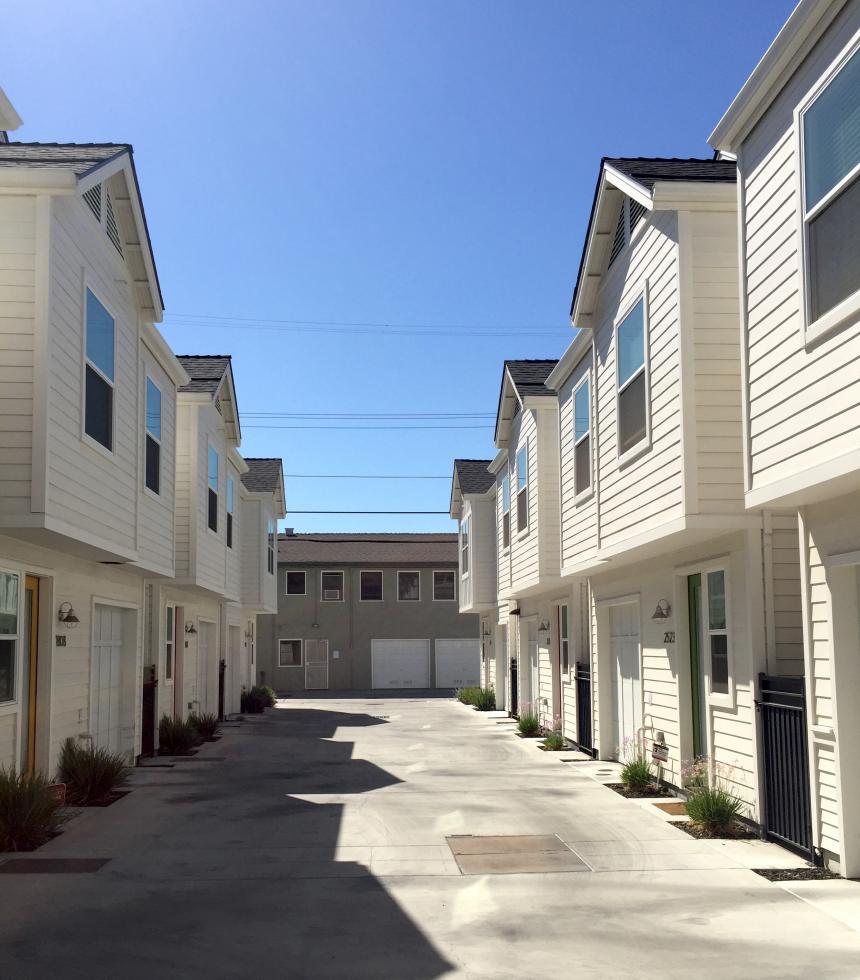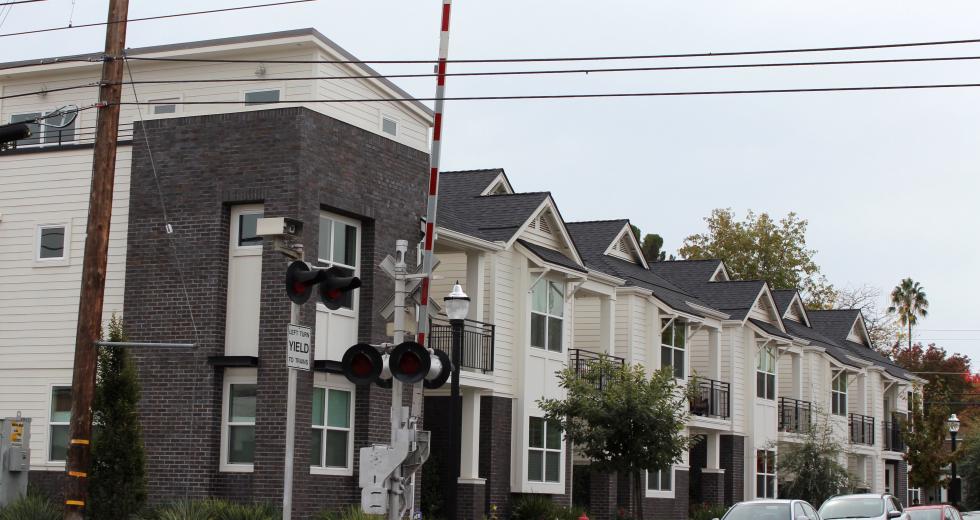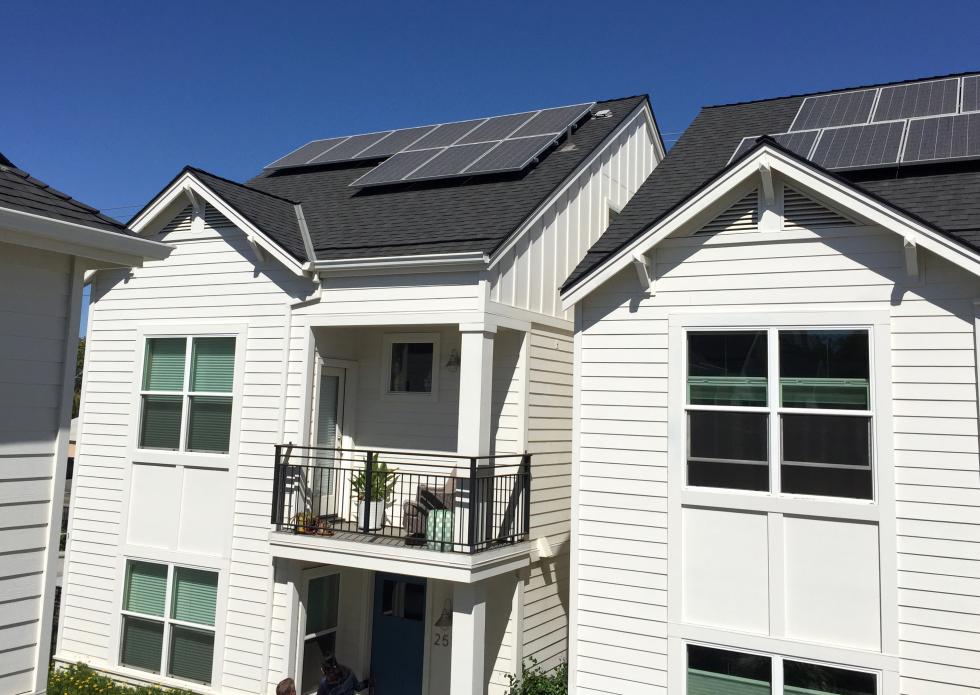Less than three years after its first resident moved in, the highly-touted energy-efficient development in Sacramento called 2500 R Street is now mired in a legal dispute over the alleged false advertising of its homes as net-zero energy and LEED-certified.
In the Statement of Claim — a legal document detailing the plaintiffs’ allegations — filed for arbitration on Sept. 30, 17 of the 34 homeowners named the developers Pacific Housing, 2500 R Group and Pach Sustainable responsible for allegedly intentionally concealing or failing to disclose that the homes did not comply with either net-zero energy or LEED-certification standards. They also claimed Cuttle Construction, along with the three aforementioned parties, neglected to design and construct the homes with reasonable care, contributing in part to the homes’ noncompliance.
“For all we know up to now, these homes were marketed as net-zero, LEED energy-efficient homes, when in fact that was more of a marketing slogan,” says Glen Van Dyke, the attorney representing the plaintiffs.
Greg Dyer, the attorney on the defendants’ side, however, says that the alleged false advertising was never his clients’ intent. “There was a third-party advertiser involved in marketing this, as opposed to the developer and the contractor, so we’re trying to get to exactly what was going on … The bottom line is my clients are quality developers that provided a quality product.”
Widely celebrated as the first net-zero energy community in Midtown Sacramento when it opened for sales in August 2013, 2500 R Street amassed numerous accolades, including being named a finalist for an innovation award from Energy Storage North America for providing a new model of sustainable and affordable housing. Pacific Housing developed the homes in partnership with the Sacramento Municipal Utility Department and Sunverge Energy to outfit each residence with a solar array and storage battery. They additionally equipped the homes with low-energy appliances and an integrated energy management system that included a smart thermostat, remotely switchable outlets, and an online energy profile for tracking and managing electricity use.
Both these energy-efficiency measures and the advertised net-zero, LEED-certification standards motivated many of the homeowners to purchase their homes, according to Van Dyke. Shortly after they moved in, however, their electricity and natural gas bills began to show positive levels of energy consumption. “I got my first utility bill and was shocked,” recalls an initial homeowner, who spoke on condition of anonymity to avoid potential backlash from neighbors who are not part of the legal dispute. His electricity bills from SMUD, for example, show an average net consumption of about 210 kWh per month, which is roughly 36 percent of the average California household, as reported by the U.S. Energy Information Agency. “So I said to the builder, ‘What’s this, I thought we were net-zero energy?’”
Half of the 34 residents of 2500 R Street have claimed the
developers intentionally misrepresented the building as net-zero
energy and LEED-certified. (photo by Karen Hao)

As concerns grew over the discrepancy between the energy bill balances and the homes’ advertised specifications, the homeowners say they began asking Pacific Housing for clarification, but found the developer’s answers unsatisfactory.
Between 2010 when the development was first proposed and 2014 when the final home sold, the developers and their partners distributed marketing materials and submitted a report to the American Council for an Energy-Efficient Economy that claimed: “The homes at 2500 R Street are Zero Energy, Zero Carbon, Zero Emissions, LEED-certified residences.” One brochure stated, “The net-zero energy homes are highly-marketable. They satisfy the desire of homeowners not only to save money on energy but also to achieve energy independence and actively address the problem of climate change.” Additionally, a report submitted to the Sacramento City Council in November 2010 requested (and received approval for) 34 sewer connection fee credits for Pacific Housing to develop the homes, largely on the basis that “the project will bring 34, anticipated LEED Platinum rating, infill housing units to the Midtown neighborhood creating a sustainable and livable community.”
Van Dyke says that the alleged lack of net-zero energy and LEED compliance decreases the monetary value of the homes, resulting in economic harm to his clients.
The same marketing materials (as well as the SMUD report to ACEEE), defined net-zero energy as the following: “Net-zero energy means that, over the course of a year, your home will generate all the electricity you’ll need.” Data presented in a December 2014 evaluation by SMUD, however, showed positive net electricity usage per household — ranging from roughly 50 to 450 kWh (9 percent to 81 percent of the California average) — for every month of 2014.
Part of this discrepancy could stem from the vague way the California Energy Commission defines the phrase “net-zero energy.” “It’s not a very easy issue,” says Spokeswoman Amber Pasricha Beck, because energy consumption varies with the way a home is operated. “When we talk here at the Energy Commission, we talk about the built home. The built home might be net-zero energy ready if used in the average way, but then once it’s occupied and operated, [the energy consumed] might be more than average or less than average.”
But the hazy definition doesn’t necessarily account for all the disparity. The initial homeowner’s utility bills from the end of 2013 to August of 2016 showed that his solar panels generated only one-third of the electricity he consumed each year, despite his relatively average consumption levels for a two-story, single-family home in the Sacramento area, based on the calculations of the California Energy Commission.
Less confusion surrounds the developers’ claims of LEED certification. According to the U.S. Green Building Council, which runs the certification program, a building’s design and construction can only be LEED accredited during the construction process. After construction is complete, retroactive accreditation is not possible. The USGBC database confirmed that 2500 R Street never received accreditation.
“My understanding is these houses were not LEED-certified,” says Dyer, the defendants’ attorney. “We’re trying to get to the bottom of [why it was advertised that way]. It may have been that the advertising didn’t understand what was being told to them. These are facts that I just don’t know at this point.”
Two homeowners interviewed say the dispute is not about the money. “If we get any settlement, it’s our hope to fix our houses; we’re not looking for emotional damages or anything like that,” says the second homeowner, who also asked to remain anonymous. The first homeowner agrees. “We’re just trying to be fair. If you go and buy a hybrid and they give you a gas car, you say, wait a second, this is not what I bought … we just want to get what we thought we were buying.”
With the filing of the Statement of Claim, the arbitration could either resolve with a private settlement or enter public court. Should the case take the first path, the terms of resolution will remain confidential.
According to the Energy Information Association, the residential and commercial sector accounts for about 40 percent of U.S. energy consumption. Thus in 2007, the California Energy Commission established an ambitious goal under Title 24 for all new residential and commercial developments to meet net-zero energy standards by 2020 and 2030, respectively. One year prior, the state had passed AB32, the Global Warming Solutions Act, which set targets to reduce greenhouse gas emissions to 1990 levels by 2020. The legal dispute over 2500 R Street makes clear that the stakeholders of Title 24 — builders, developers and the Energy Commission itself — have a lot of work ahead to clearly define what the goal actually means. Otherwise, there could be more confusion and alleged misrepresentation.
“I think it’s important,” Van Dyke says, “with the rise of energy efficiency technology and the California goals for net-zero residential homes and eventually the codification of those requirements, that that particular trend isn’t misused by developers and builders to sell homes as opposed to build homes that meet those requirements.”
Clarification: The original version of this article misidentified a definition of net-zero energy as coming from a 2014 evaluation by SMUD; it actually came from a different SMUD report presented to the American Council for an Energy-Efficient Economy.




